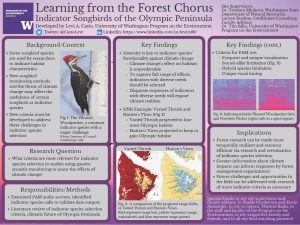Learning From the Forest Chorus: Indicator Songbirds on the Olympic Peninsula
Forest management organizations need to understand how their managed forest stands respond to disturbance in order to make more informed management decisions.. To understand the effects of disturbance, these organizations can monitor the occupancy of their stands by certain species with specific habitat needs, called indicator species. Passive Acoustic Monitoring (PAM) is a relatively new method for occupancy monitoring, wherein autonomous recording devices are placed in forest stands to gather audio recordings of species occupying the stand. The Washington State Department of Natural Resources (DNR) is currently researching the use of PAM for assessing occupancy of indicator songbirds in forests on the Olympic Peninsula. In addition to aiding in this research by validating PAM audio survey data, I have made indicator species selection criteria the subject of my independent research, so that forest managers can monitor songbirds that are fitting to their research objectives. A thorough literature review has informed my development of new criteria for consideration when selecting indicator songbirds in studies utilizing PAM, with special attention to the anticipated effects of climate change on the Olympic Peninsula. Major new criteria include easily identifiable vocalizations and varied anticipated responses to climatic effects. These criteria can be utilized for future studies on the Olympic Peninsula and elsewhere to produce more robust and efficient indicator songbird selections. The process by which future researchers might screen indicator songbird candidates using these criteria is modeled in this study’s assessment of current indicator species used by the DNR.
